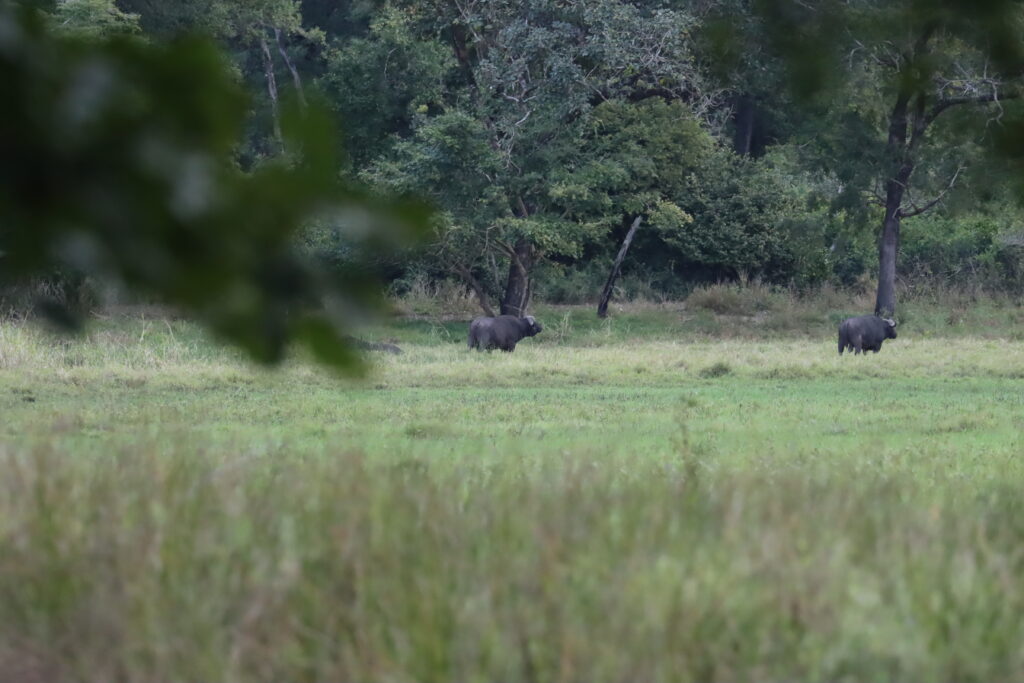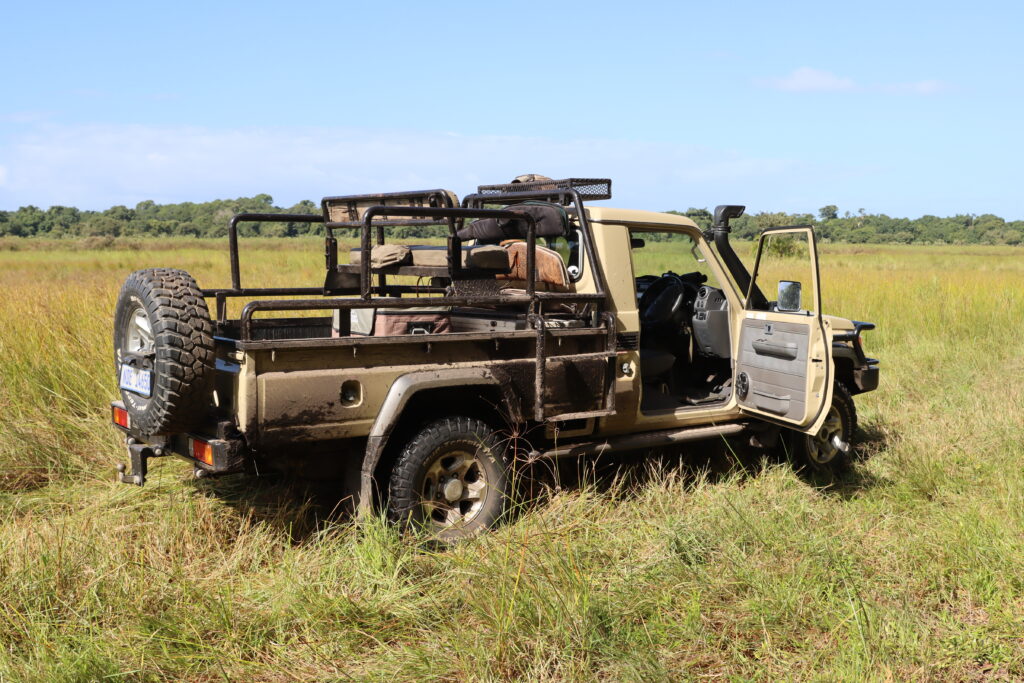Warthog Life Insurance
There’s One Lucky Hog Rooting Around In Mozambique
By Mike Arnold
Originally published in the March/April 2024 issue of Safari Magazine.
“Right over the top of him,” I said as I watched a heavy-tusked warthog disappear into the Miombo forest edge at a full gallop.
“That was a quick snapshot,” said PH Julian Moller. “Don’t beat yourself up about it.”
But I knew better. The boar had run straight away from us. All I’d needed to do was hold low on his backside, and we would have had our trophy. Instead, I held on the root of his tail and all we had was a startled hog.
This was the first animal I shot at on my first safari to Zambeze Delta Safaris in Mozambique. Thankfully, I would not miss another shot on this first safari. But, when I came back for a second safari, things didn’t go as well.
My main purpose for heading to Coutada 11 in May and in July 2021 was to collect material for my book, “Bringing Back the Lions.”
Part of that research involved hunting several species found in abundances in that expansive hunting concession of more than 7,700 square miles. And it was full of game.
According to recent surveys, there were more than 30,000 Cape buffaloes, 3,000 sable antelopes and 25,000 waterbucks. These numbers are even more staggering when you consider that very few individuals of these three species, or any other species in Coutada 11, were hunted to near extirpation by fighting factions during the country’s horrible civil war that lasted from 1977 to 1992 when there were 1,200 Cape buffaloes, a few hundred waterbucks at most, and 30 sables.

Game animals of all sorts, as well as birds, insects, reptiles and amphibians now abound in Coutada 11’s protected environs.
During my visits to the Zambeze Delta Safari concession, one of the most seen species was Phacochoerus africanus, or the common warthog. Its Latin name, Phacochoerus, is a combination of two Greek words, phakos meaning mole or wart and khoiros meaning pig or hog.
We never seemed out of sight of these unusual looking mammals. Whether on the grass landing strip 100 yards from camp, or at the furthest borders of the hunting concession, warthogs trotted away at the approach of vehicles, tails held straight up like aerials searching for a signal.
Most frequently encountered were sows with their young, but boars were legion as well. Their prevalence wasn’t too surprising, given that the 2019 biological survey estimated as many as 10,000 individuals roaming the Coutada 11 landscape.
This number also reflects the amazing restoration of habitats and wildlife from the work of Zambeze Delta Safaris Staff and the local Sena villagers. When Zambeze Delta Safaris took over in 1992, there were an estimated 100 warthogs.
I never tired of seeing the so-ugly-they’re-cute hogs. But their habit of rooting for their food creates havoc with roads and airstrips. I was thrown around inside Julian’s Land Cruiser like a ragdoll, due to warthog impressive rooting on the road. At the time, they had not been able to grade many of the roads, due to a lack of income during the coronavirus days.
A lack of hunters also meant that there was an increase in the age classes of game animals, and thus trophy quality. In Coutada 11, 2021 was a special year. An extra year of aging and growth meant taking trophy animals that exceeded previous norms of length and mass.
For warthogs, it also meant aged individuals on their last legs. The PH said they had never seen so many animals that limped and staggered away as we approached in a vehicle or on foot. In fact, we even encountered carcasses of animals apparently not killed by predators, but rather seeming to have simply laid down and died.
Of course, the wealth of old warthogs meant the chance of running across an exceptional trophy. At the edge of a flooded pan, we did just that.
Guiding me on this second foray was PH Dylan Holmes, and his Sena tracker Albiño. Dylan parked his Land Cruiser about 200 yards inside a woodland, near some fallen trees, pushed over by feeding elephants. Albiño quickly removed the rifle from its padded case and handed it to me along with shooting sticks. We made our way up the narrow track toward the pan.
As we neared the edge of the trees, we glassed the open area stretching for several hundred yards in all directions. I don’t know who saw the warthog first, but after a minute of glassing, Dylan turned to me.
“That is a massive hog,” he whispered. “I don’t think I’ve ever seen one with larger tusks.”
There was a large mahogany tree between us and where the warthog fed on the edge of the high grass. All we had to do was make our way quietly to the tree and we would be within 75 yards of the trophy. There was even a handy fork in the mahogany, just at chest height. So, I would not need to step to the side of the tree to use the rest, but instead could stay behind the obstacle and thus not risk the hog catching sight of me.
The stalk worked perfectly. The warthog kept feeding. I slipped the camp rifle in .300 Win. Mag. into the fork of the tree, silently moved the safety to fire, lined up the sights and squeezed the trigger.
“You shot off the top half off his tusk,” said Dylan as he watched the warthog run. I chambered another round but couldn’t get another shot off.
Dylan and Albiño headed to the track taken by the boar as it streaked to the cover of the miombo forest. Slowly we looked for blood or hair. Nothing. After an hour, they concluded that the boar probably had a headache and a toothache, but nothing else.
Personally, I was devastated by what I’d done. But relieved the boar was not carrying a bullet wound. Later, I told outfitter Mark Haldane I’d be glad to pay for the warthog.
“No blood, no payment,” he said.
As we made our way back to the truck, Dylan was speaking with Albiño and they both laughed.
“You just bought that boar a life insurance policy,” said Dylan. “No client will want a warthog with one of its tusks shot in half.”
We all laughed, but the levity didn’t penetrate my gloom. It would take several days, some good-natured kidding by other PHs, trackers and camp staff about warthog life insurance before I would lighten up and start accepting that everyone makes a bad shot occasionally. Yes, mine was a doozy, but it wasn’t going to help for me to sulk about it, and in fact would likely contribute to additional poor shooting if I didn’t relax and go on.
We spent the remaining several days in the concession cruising likely areas, stalking other pans. We saw many, many hogs while driving, stalking and sitting on stands. None came close in size to the one with half a tusk that got away.

Our luck finally turned on the next to last day of the safari. Stalking along the edge of another pan, Dylan pushed his hand back toward me in the international stop sign. A warthog was rooting in a patch of 7-foot-tall grass near the pan’s edge. As the hog shuffled along, swinging his head from side-to-side looking for roots and other tasty food, I saw flashes of white.
Dylan brought me to his side while Albiño opened the rest.
“This is a great boar,” whispered Dylan. “Not as big as the first one, but he is old and has great length and mass. You need to take him.”
Sliding the rifle onto the rest, I found I was more nervous than I’d been for any of the other animals I’d taken. I gasped for air and my hands were trembling slightly. I guess I wasn’t past the trauma of the first warthog experience. I was able to settle down a bit, place the crosshairs onto the boar’s shoulder and pull the trigger. At the shot, the hog dropped. He regained his feet and charged into an acre of miombo thorn.
“Not again,” I said.
“You hit him hard,” said Dylan. “Don’t worry, we’ll find him.”
It took a bit of tracking, but we found the boar on the other side of the thornbush.
This old boar was bald on the top of his head and his teeth were worn down to the gums. This was a perfect, ancient individual that would likely not have made it through another wet season. The exposed portions of his tusks were just over 11 inches. I was very happy with this trophy.

The first boar — the one with half of a tusk — would have beaten my hog by a good 4 inches. While he might still have a toothache, that guy is lucky to have a fully paid life-insurance policy at least as far as hunters are concerned.
Dr. Mike Arnold is a Life member of SCI, and author of “Bringing Back The Lions,” a book about the rewilding of a region in Mozambique. You can purchase the book at safariclub.org/shop.

